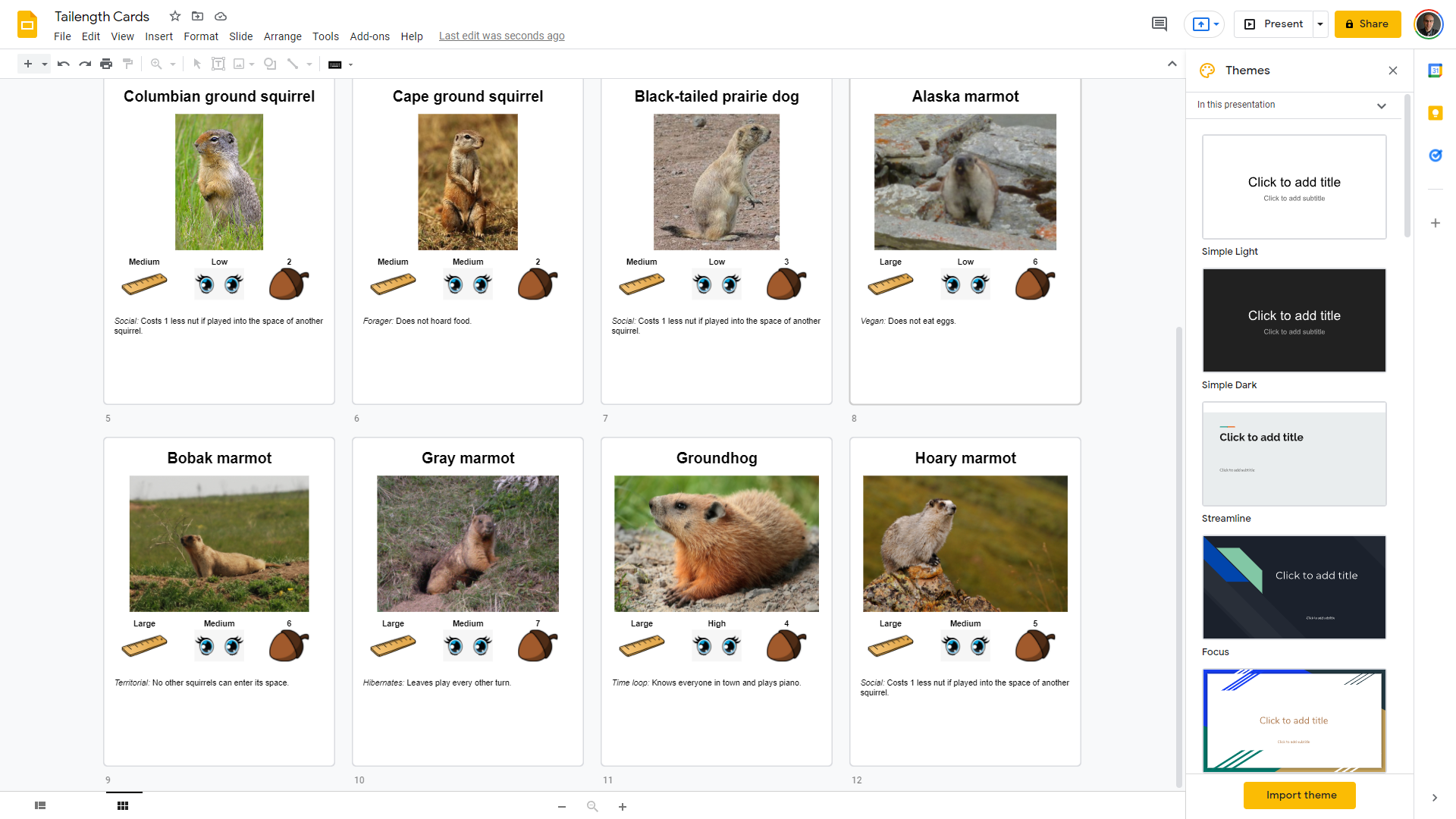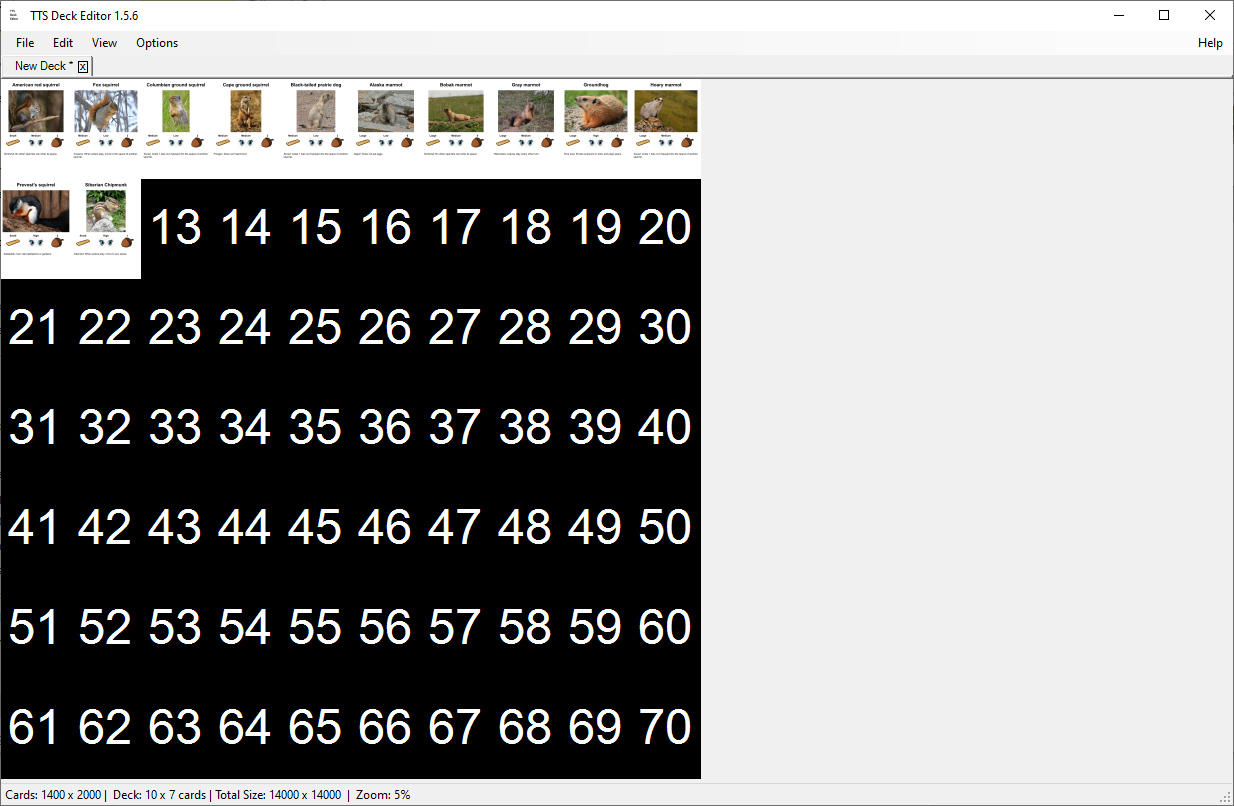How To Add Custom Cards Into A Deck Duelingbook
Creating Custom Cards On Tabletop Simulator
A step-by-step guide to making a deck of cards on Tabletop Simulator by guest writer Elli Amir (He/They)!

Tabletop Simulator is the perfect tool for chop-chop developing your board game, including unique cards and decks. And then, to help with that, this article will lay out an easy and fast workflow for importing cards into Tabletop Simulator. I will too suggest a few ideas for helping with your game design and evolution process based on my all-encompassing work on Tabletop Simulator playtesting my upcoming card game, Worldbreakers: Advent of the Khanate.
To get a feel for the process, permit's start with an instance: You are developing a new board game called "Tailength". Tailength is a competitive squirrel-collection, engine-building game for 1-v players. Y'all take a rough sketch of the rules and ideas for the game board and the different resources players will accumulate. You plan to stand for each squirrel with a Squirrel Carte that will list its gameplay attributes: size, cuteness level, a nut price, and a special power. Concluding but not to the lowest degree, each card will take an oil painting depicting the cute animal in its natural habitat. You are set up to get-go playtesting a few early bill of fare ideas in Tabletop Simulator.
Designing the menu layout
The first footstep is designing the card layout, the concrete position of the name, attributes, ability text, and fine art on the card. The best style to pattern the layout is to have ane of the cards and apply that as a model. For Tailength we volition utilise the "Prevost's squirrel" card, which has a size of "Small", a cuteness level of "Loftier", a nut cost of ane, and the "Adaptable" ability.
To design our bill of fare, we are going to use Google Slides since information technology is gratuitous, familiar to a wide audience, and sits on the cloud (which ways everything is backed up automatically!). Showtime a new Slides document and remove the default slide layout by going to the "Slide" menu and choosing "Apply Layout >" and and so "Blank". Adjacent, nosotros are going to modify the slide size to 7 10 10 inches, which is the default proportion of card size in Tabletop Simulator. To do this, click on "File" menu and "Page setup". Change the top dropdown to "Custom", the metric dropdown to "Inches", and the values to vii and x, respectively.

Now we have a clean slate and can start populating it with the card proper noun and the unlike attributes. Always focus on part rather than style. You lot want to make sure that the card 1) includes all of the information needed to play the game and 2) presents it in an easily-accessible format. Here are a few pointers for your design:
-
Bill of fare names typically appear at the superlative of the card with a large bold font (at to the lowest degree thirty points).
-
For now, place any attributes either to the left or at the center of the carte du jour and then that players have an easy time finding them.
-
Carte text can have lower font sizes. I propose staying at xviii points or more for readability.
-
Many games take keywords that communicate certain mechanics to the reader. You lot tin can represent these using italics, bold, capitalization.
-
Incorporating some minimal graphics will make playtesting more than constructive and fun. Include an icon for whatsoever menu attributes and try to find a unique image for each card. Google is your friend: search for "TERM clipart free" and the top few results should have something advisable.
* It's important to remember that at that place are several elements that could become time sinks while not straight contributing to your game's evolution. In particular, decisions effectually font face choices, card frame, and text and groundwork colors tin can look until your game is more mature. The Google Slides defaults (Arial and black for font, white for groundwork color) look good in Tabletop Simulator and are an excellent starting signal.
Here is our model Squirrel card, Prevost's squirrel:

Creating the cards
We will use this model carte du jour every bit a layout for all of the different cards in the game. Correct click on the model card slide and so, in the slide navigator to the left, choose "Duplicate slide". This will create a copy of the model card. Update the title, attributes, ability, and image as needed to create the side by side Squirrel:

Repeat this process for the remaining cards in your game.

* Another note to call up: Playing a game for the first few times is a very educational experience. Your ideas will evolve and diverge speedily as you get a better feel on what makes your game fun and which pitfalls to avoid. So, fifty-fifty if yous envision having hundreds of unique cards downward the line, you probably simply need a handful of cards for now. Create enough cards to play a couple of turns and then organically add more as development progresses.
Generating the card prototype collage
Tabletop Simulator uses a collage format in gild to import cards. In a collage, the card images are placed next to each other in a filigree shape, forming one big image. The Tabletop Simulator default has x cards in each filigree row and seven cards in each grid cavalcade. This is how our twelve Squirrel cards await like as a collage:

Next, nosotros will go through three steps to convert the Google Slides document to the collage:
-
Step 1: Download the slides as PDFs. In Google Slides, under the "Files" menu, click on "Downloads >" and then "PDF Document (.pdf)".
-
Step ii: Convert the PDFs into PNGs. In that location are several tools that break down a PDF into split up PNG images, with 1 image for each page. I recommend (pdf2png.com)[pdf2png.com]. In one case your PNGs are compiled, yous can download the result as a ZIP file. One time download is consummate, unzip the file.
-
Step three: Combine the PNGs into a unmarried collage PNG. Tabletop Simulator has a Deck Builder app that combines the single images into the collage. To find it, go to Steam. So, nether the "Library" tab, you will see a list of your games to the left. Right-click on "Tabletop Simulator", choose "Manage >" and "Browse local files". This will open a file browser where you can enter the "Modding" directory, so "Deck Builder", and finally run TTS-Deck-Editor. Within the deck architect, click on "New Deck". Drag-and-drop your unmarried-image PNGs into the resulting dialog, and you should see all of your cards in montage grade:

Finally, click on "File" and and then "Consign". The "Consign" dialog will open. Check off "Max Deck Size" and make sure the number is set to 4096. Then click on "Export" and choose where to relieve the file.
Your collage is ready! Let's go into Tabletop Simulator and bring your cards to life!
Importing the deck into Tabletop Simulator
Allow'due south start with an empty board and create our custom deck at that place. Outset, launch Tabletop Simulator and in the starting menu choose "Create" and "Singleplayer". In the following "Games" dialog, click on the blood-red "10" in the top right, and you will run across an empty table.
Now, click on "Objects" at the top, then "Components", "Custom", and "Deck". Your cursor volition go a pawn hovering over a white rectangle which represents your future deck. Click at the middle of the table to drop it and and so correct-click to open the "Custom Deck" dialog. We are going to update several of the options here.
First and foremost, the "Face" field is where y'all enter your collage image. Click on the yellow folder icon to the right of it to open a file browser. Observe your collage PNG and cull it. Tabletop Simulator will inquire you whether you lot desire to upload the file to the Steam Cloud. If you only program to play your game locally, choose "Local". Notwithstanding, annotation that you should not move the collage file or Tabletop Simulator will non be able to find it in the hereafter. Alternatively, if you program to play your game online with other people, cull "Cloud" and so "Upload".
Next, you should choose a dorsum for your cards. Similar to earlier, you tin create a blank slide in Google Slides, download information technology as a PNG ("File", "Download >", and "PNG image (.png, current slide)") and utilize that. Choose either "Local" or "Cloud", so "Upload" as before.
The "Width" and "Height" indicate the number of rows and columns in the collage file. Since we used the deck builder defaults, you lot can get out these at 10 and 7. Next is the "Number" field which is the number of cards in the file. In the instance of Tailength, that number is 12.
Finally, check off the "Back is Hidden" box. This will tell Tabletop Simulator that when players hold cards in their hands, opponents will meet your bill of fare back image as the bill of fare backs.
Congratulations! Your cards are in Tabletop Simulator. To make certain all of the cards are there, y'all tin right click the deck and choose "Search". This will open a browser with all of the files to the right. Alternatively, you tin can right click the deck and choose "Flip" and and then "Spread". All of your cards will be laid out in front of you.
Happy playtesting!

…
Thank you for reading. If you reached this far I am guessing that you lot dearest bill of fare games. I am developing Worldbreakers: Advent of the Khanate, a customizable 2-role player card game fix in alternative 13th century history. Worldbreakers is fast-paced, alternating between the players i action at a time. Players acquire resources, recruit Followers, and accelerate special Location cards for Power. If you would similar to acquire more, delight bring together the Worldbreakers mailing list at this link!

Encounter Elli Amir!
Elli is the designer of Worldbreakers: Advent of the Khanate, an upcoming customizable ii-histrion card game fix in alternative 13th-century history. They have been a playtester for Android: Netrunner, Star Wars: Destiny, and numerous other board and carte games.
How To Add Custom Cards Into A Deck Duelingbook,
Source: https://blog.tabletopsimulator.com/blog/create-cards-for-your-game-with-tts
Posted by: kentunclefor.blogspot.com


0 Response to "How To Add Custom Cards Into A Deck Duelingbook"
Post a Comment